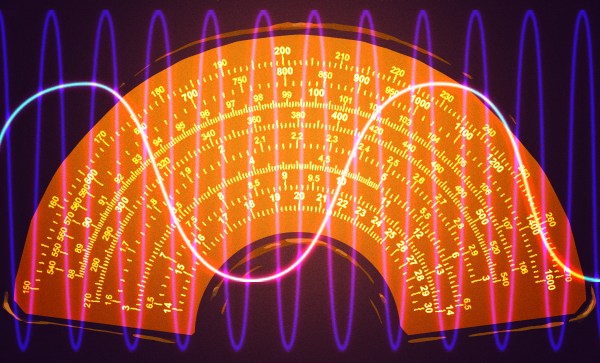It is one of Murphy’s laws, we think, that you can’t get great things when you need them. Back in the heyday of shortwave broadcasting, any of us would have given a week’s pay for even a low-end receiver today. Digital display? Memory? Digital filtering? These days, you have radios, and they aren’t terribly expensive, but there isn’t much to listen to. Making matters worse, it isn’t easy these days to string wires around in your neighborhood for a variety of reasons. Maybe you don’t have a yard, or you have deed restrictions, or your yard lacks suitable space or locations. This problem is so common that there are a crop of indoor antennas that seem attractive. Since I don’t often tune in shortwave and I don’t want to have to reset my antenna after every storm, I decided to look at the Tecsun AN-48X along with a YouLoop clone from China. Let’s start with the Tecsun. Continue reading “An Antenna To Throw You For A Loop”
Featured2978 Articles
Longform articles, the best of what the Hackaday writing crew has to offer.
Ask Hackaday: Is Shortwave On Life Support?

Between World War II and Y2K, shortwave listening was quite an education. With a simple receiver, you could listen to the world. Some of it, of course, was entertainment, and much of it was propaganda of one sort or another. But you could learn a lot. Kids with shortwave radios always did great in geography. Getting the news from a different perspective is often illuminating, too. Learning about other cultures and people in such a direct way is priceless. Getting a QSL card in the mail from a faraway land seemed very exciting back then.
Today, the shortwave landscape is a mere shadow of itself. According to a Wikipedia page, there are 235 active shortwave broadcasters from a list of 414, so nearly half are defunct. Not only are there many “dead” shortwave outlets, but many of the ones that are left are either not aimed at the world market or serve a niche group of listeners.
You can argue that with the Internet, you don’t need radio, and that’s probably correct in some ways but misses a few important points. Indeed, many broadcasters still exist as streaming stations or a mix of radio and streaming. I have to admit I listen to the BBC often but rarely on the air. My computer or phone plays it in crystal clarity 24 hours a day.

So, while a 14-year-old in 1975 might be hunched over a radio wearing headphones, straining to hear NHK World Radio, these days, they are likely surfing the popular social media site of the week. You could easily argue that content on YouTube, Instagram, and the like can come from all over the world, so what’s the problem?
The problem is information overload. Faced with a shortwave radio, there were a limited number of options available. What’s more, only a small part of the band might be “open” at any given time. It isn’t like the radio could play games or — unless you were a ham — allow you to chat with your friends. So you found radio stations from Germany to South Africa. From China and Russia, to Canada and Mexico. You knew the capital of Albania. You learned a little Dutch from Radio Nederlands.
Continue reading “Ask Hackaday: Is Shortwave On Life Support?”
End Of An Era: Sony Cuts Production Of Writable Optical Media
The 1990s saw a revolution occur, launched by the CD burner. As prices of writeable media and drives dropped, consumers rushed to duplicate games, create their own mix CDs, and backup their data on optical disc. It was a halcyon time.
Fast forward to today, and we’re very much on downward curve when it comes to optical media use. Amidst ever-declining consumer interest, Sony has announced it will cut production of writeable optical media. Let’s examine what’s going on, and explore the near future for writable optical discs.
Continue reading “End Of An Era: Sony Cuts Production Of Writable Optical Media”
The Rise Of The Disappearing Polymorphs
Science and engineering usually create consistent results. Generally, when you figure out how to make something, you can repeat that at will to make more of something. But what if, one day, you ran the same process, and got different results? You double-checked, and triple-checked, and you kept ending up with a different end product instead?
Perhaps it wasn’t the process that changed, but the environment? Or physics itself? Enter the scary world of disappearing polymorphs.
Continue reading “The Rise Of The Disappearing Polymorphs”
You Can Use LEDs As Sensors, Too
LEDs are a wonderful technology. You put in a little bit of power, and you get out a wonderful amount of light. They’re efficient, cheap, and plentiful. We use them for so much!
What you might not have known is that these humble components have a secret feature, one largely undocumented in the datasheets. You can use an LED as a light source, sure, but did you know you can use one as a sensor?
Reviewing Nuclear Accidents: Separating Fact From Fiction
Few types of accidents speak as much to the imagination as those involving nuclear fission. From the unimaginable horrors of the nuclear bombs on Nagasaki and Hiroshima, to the fever-pitch reporting about the accidents at Three Mile Island, Chernobyl and Fukushima, all of these have resulted in many descriptions and visualizations which are merely imaginative flights of fancy, with no connection to physical reality. Due to radiation being invisible with the naked eye and the interpretation of radiation measurements in popular media generally restricted to the harrowing noise from a Geiger counter, the reality of nuclear power accidents in said media has become diluted and often replaced with half-truths and outright lies that feed strongly into fear, uncertainty, and doubt.
Why is it that people are drawn more to nuclear accidents than a disaster like that at Bhopal? What is it that makes the one nuclear bomb on Hiroshima so much more interesting than the firebombing of Tokyo or the flattening of Dresden? Why do we fear nuclear power more than dam failures and the heavy toll of air pollution? If we honestly look at nuclear accidents, it’s clear that invariably the panic afterwards did more damage than the event itself. One might postulate that this is partially due to the sensationalist vibe created around these events, and largely due to a poorly informed public when it comes to topics like nuclear fission and radiation. A situation which is worsened by harmful government policies pertaining to things like disaster response, often inspired by scientifically discredited theories like the Linear No-Threshold (LNT) model which killed so many in the USSR and Japan.
In light of a likely restart of Unit 1 of the Three Mile Island nuclear plant in the near future, it might behoove us to wonder what we might learn from the world’s worst commercial nuclear power disasters. All from the difficult perspective of a world where ideology and hidden agendas do not play a role, as we ask ourselves whether we really should fear the atom.
Continue reading “Reviewing Nuclear Accidents: Separating Fact From Fiction”
Secrets Of The Old Digital Design Titans
Designing combinatorial digital circuits seems like it should be easy. After all, you can do everything you want with just AND, OR, and NOT gates. Bonus points if you have an XOR gate, but you can build everything you need for combinatorial logic with just those three components. If all you want to do is design something to turn on the light when the ignition is on AND door 1 is open OR door 2 is open, you won’t have any problems. However, for more complex scenarios, how we do things has changed several times.
In the old days, you’d just design the tubes or transistor circuits you needed to develop your logic. If you were wiring up everything by hand anyway, you might as well. But then came modules like printed circuit boards. There was a certain economy to having cards that had, say, two NOR gates on a card. Then, you needed to convert all your logic to use NOR gates (or NAND gates, if that’s what you had).
Small-scale ICs changed that. It was easy to put a mix of gates on a card, although there was still some slight advantage to having cards full of the same kind of gate. Then came logic devices, which would eventually become FPGAs. They tend to have many of one kind of “cell” with plenty of logic gates on board, but not necessarily the ones you need. However, by that time, you could just tell a computer program what you wanted, and it would do the heavy lifting. That was a luxury early designers didn’t have. Continue reading “Secrets Of The Old Digital Design Titans”

















